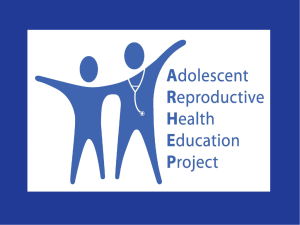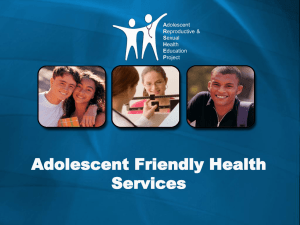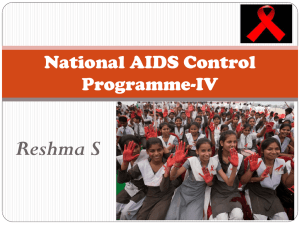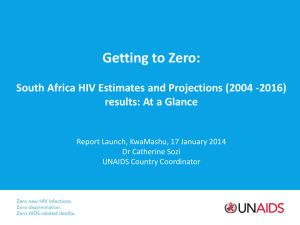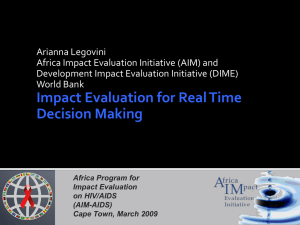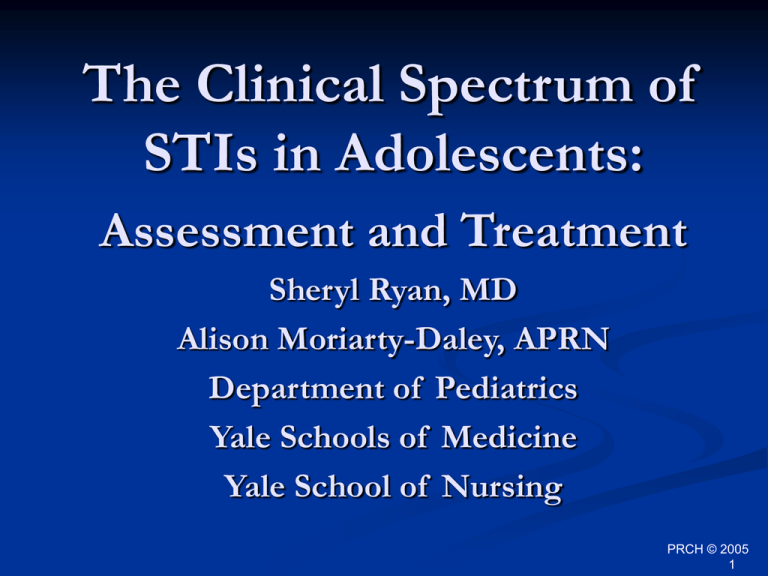
The Clinical Spectrum of
STIs in Adolescents:
Assessment and Treatment
Sheryl Ryan, MD
Alison Moriarty-Daley, APRN
Department of Pediatrics
Yale Schools of Medicine
Yale School of Nursing
PRCH © 2005
1
Objectives
By the end of this presentation, participants will
be able to:
Describe the scope and risk factors for sexually
transmitted infections in adolescents.
Screen adolescents utilizing guidelines.
Treat adolescent patients utilizing treatment
guidelines for many of the most common STIs seen
in adolescents.
PRCH © 2005
2
Scope of Sexually Transmitted
Infections
18.9 million new cases of sexually transmitted
infections occur annually.
Most STIs remain undiagnosed.
48% of cases occur in people ages 15-24.
By age 24, at least 1 in 3 sexually active people
will have contracted an STI.
Economic costs of STI treatment per year are
estimated to be at least $8.4 billion.
PRCH © 2005
3
Chlamydia: Age and Sex-Specific
Rates: United States, 2004
Rate (per 100,000 population)
3000
2500
2000
Men
Women
1500
1000
500
To
ta
l
65
+
10
-1
4
15
-1
9
20
-2
4
25
-2
9
30
-3
4
35
-3
9
40
-4
4
45
-5
4
55
-6
4
0
PRCH © 2005
4
Gonorrhea: Age and Sex-Specific Rates,
United States, 2004
Rate (per 100,000 population)
700
600
500
Men
Women
400
300
200
100
l
To
ta
65
+
10
-1
4
15
-1
9
20
-2
4
25
-2
9
30
-3
4
35
-3
9
40
-4
4
45
-5
4
55
-6
4
0
PRCH © 2005
5
Why Focus On Adolescents?
Younger people are more likely to adopt and
maintain safe sexual behaviors than are older
people with well-established sexual habits,
making youth excellent candidates for
prevention efforts.
Reducing adolescent infections will ultimately
result in fewer infections among all age groups.
PRCH © 2005
6
Behavioral Risk Factors for STIs
in Adolescents
Age at first sexual intercourse
Sexual activity with a new partner
Multiple sexual partners
Substance use
PRCH © 2005
7
Risk Factors for STIs in
Adolescence
Age at first sexual intercourse
Women with 1st sexual intercourse < age 15 are:
Sexual activity with a new partner
Nearly four times as likely to report a bacterial STI and
More than twice as likely to report PID, as women who first had sex
after age 18.
Several studies have shown that being in a new sex
partnership is a predictor of an STI due to greater uncertainty
about partners’ sexual history and STI status.
Multiple sexual partners
More than one at a time sexual partner increases exposure
and therefore increases risk of STI.
CDC reports that about 16% of 14-19 year olds reported four
PRCH © 2005
or more sexual partners in their lifetime.
8
Cognitive Risk Factors for STIs in
Adolescents
Young adolescents are concrete thinkers:
Often unable to plan ahead for condoms
Serial monogamy in relationships
Personal fable
Unable to judge risk for STIs
“Other people get STIs”
PRCH © 2005
9
Ever Had Sexual Intercourse, 2005 YRBS
By The End of High School, The Majority of Students Will
Have Had Sexual Intercourse
80%
70%
60%
50%
63%
47%
48% 46%
40%
51%
43%
34%
30%
20%
10%
0%
Total
Male Female
9th 10th 11th 12th
Grade
PRCH © 2005
10
Percentage of Males and Females Ages
15–19 Who Reported Ever Having Oral Sex:
2002 NSFG
100%
90%
80%
70%
60%
50%
40%
30%
20%
10%
0%
Male
Female
Any Oral Sex Ever Gave Oral Ever Received
Sex
Oral Sex PRCH © 2005
11
Contraceptive Method at Last Intercourse
15–19 year olds, 2002 NSFG
Teens Are Still Not Using Contraception 100% of the Time
Other, 5%
Hormonal
Only
24%
Dual Use,
20%
Other, 7%
No
Method
9%
No
Method
17%
Condom
Only
35%
Female
Condom
Only
47%
Dual Use
30%
Male
PRCH © 2005
12
Clinical Cases
PRCH © 2005
13
Case 1
An 18 year old comes into clinic to “get checked
out” for STDs. She has been sexually active with
her boyfriend for 6 months, reports using
condoms “all the time”, and does not think that
her boyfriend is cheating on her, but “you never
know”………..She has no symptoms.
She wants to be checked for GC, CT, HIV and
syphilis.
What do you send? What is the most likely organism
you will recover?
PRCH © 2005
14
Choice of Screening Labs
Routine screening of all sexually active teens asymptomatic
Gonorrhea – Nucleic acid tests
Chlamydia – Nucleic acid tests
Males – urine; females – cervical >vaginal swab >urine
Universal screening for HIV
Males – urine; females – cervical >vaginal swab>urine
Blood vs. rapid tests
Syphilis
Recommended in high rate areas – VDRL, RPR
PRCH © 2005
15
Chlamydia Screening
All sexually active adolescent females and males
should be screened for Chlamydia at least
annually.
Urine specimen for males; cervical specimen
preferred for females unless pelvic exam not feasible
Provider should counsel that partner must be
informed/treated to prevent reinfection.
Repeat testing in adolescents 3-4 months after
treatment for Chlamydia due to high rate of
reinfection.
PRCH © 2005
16
Gonorrhea Screening
Routine screening for gonorrhea is recommended for
asymptomatic women at high risk of infection, including
young women (under age 25) with two or more sex
partners in the last year.
Vaginal culture remains an accurate screening test when
transport conditions are suitable.
Newer screening tests, including nucleic acid amplification tests
and nucleic acid hybridization tests, have demonstrated
improved sensitivity and comparable specificity when
compared with cervical culture.
Some newer tests can be used with urine and vaginal swabs,
which enables screening when a pelvic examination is not
performed.
Routine screening of sexually active males recommended
PRCH © 2005
17
Guidelines Changes Based On
New Technology
Nucleic Acid Amplification Tests
More sensitive C. trachomatis (CT) test
Non-invasive specimens (urine)
Can detect CT and N. gonorrhoeae (GC) in same
specimen
Usually more expensive
New data on females – vaginal swab more
sensitive that urine
PRCH © 2005
18
Case 1 continued
48 hours after you have sent her urine screening
labs, a positive probe for Chlamydia is reported
to your office………….
You see her back to discuss the results and she
is still asymptomatic.
How do you treat her? Her partner(s)?
PRCH © 2005
19
Treatment of Asymptomatic
Infections
Single dose treatment appropriate for GC and
CT
Azithromycin 1 gram po
Ceftriaxone 125 mg IM or Cefixime 400 mg
PRCH © 2005
20
CDC STI Treatment Guidelines:
Key Counseling Tips
Discussions should be appropriate for the patient's developmental
level and should identify risky behaviors (e.g., sex and drug-use
behaviors).
Providers should:
Inquire about sexual behavior
Ask for specifics and avoid heterosexist language
Do not limit their patient interview to questions about
heterosexual vaginal-penile intercourse
Assess risk for STIs.
Counsel about risk reduction, and
Screen for asymptomatic infection during clinical encounters.
PRCH © 2005
21
CDC STI Treatment Guidelines:
Key Counseling Tips (Cont.)
The style and content of counseling and health
education should be adapted for adolescents.
Careful counseling and thorough discussions are
particularly important for adolescents who may
not acknowledge that they engage in high-risk
behaviors.
Counseling should be direct and nonjudgmental.
PRCH © 2005
22
Case 2
A 16 year old female comes into the clinic with a
complaint of vaginal discharge for one week.
She is sexually active with two partners, using condoms
“most of the time…”
The discharge is described as thick, whitish, with a “bad
smell”.
On exam, you find a homogeneous discharge, cream
color, non-specific odor
On wet prep you see WBCs, normal epithelial cells and
no hyphae.
She has only mild dysuria, no abdominal pain
PRCH © 2005
23
Vaginitis
What organisms/etiologies do you need to
consider?
How does the wet prep help you?
WBCs
Organisms
Hyphae
Trichomonads
What other clinical findings on pelvic exam can
help you?
PRCH © 2005
24
Vaginitis – Clinical Pearls
WBCs present – think inflammation
Yeast – thick, white, adherent discharge
Trichomonas – thin, greenish, frothy
Upper infection present – WBCs, neither hyphae or
trichomonads seen, mucopurulent cervical discharge
No WBCs seen
Physiologic leukorrhea
Bacterial vaginosis – clue cells
PRCH © 2005
25
Saline microscopy in vulvovaginal candidiasis
Taken from: Goldfarb A. Atlas of Clinical Gynecology: Pediatric and Adolescent Gynecology. Edited by Morton Stenchever (series
editor), Alvin F. Goldfarb. ©1998 Current Medicine LLC.
PRCH © 2005
26
Hyphae and blastospores in vulvovaginal candidiasis
Taken from: Goldfarb A. Atlas of Clinical Gynecology: Pediatric and Adolescent Gynecology. Edited by Morton Stenchever (series editor),
Alvin F. Goldfarb. ©1998 Current Medicine LLC.
PRCH © 2005
27
Bacterial vaginosis
Taken from: Spitzer M, Mann M. Atlas of Clinical Gynecology: Gynecologic Pathology. Edited by Morton Stenchever (series editor), Barbara Goff.
©1998 Current Medicine, Inc
PRCH © 2005
28
Trichomonas Vaginal Discharge
PRCH © 2005
29
Motile trichomonads in Trichomonas vaginitis
Taken from: Soper D. Atlas of Infectious Diseases: Urinary Tract Infections and Infections of the Female
Pelvis. Edited by Gerald Mandell (series editor), Jack D. Sobel. ©1997 Current Medicine, Inc.
PRCH © 2005
30
Trichomonas Infection
What is it: A microscopic parasite. One of the most
common STIs mainly affecting women
Symptoms:
Women
About
50% of women are asymptomatic carriers
Symptoms include: foul smelling or green discharge
from the vagina, vaginal itching or redness, painful
intercourse, abdominal discomfort, the urge to
urinate and dysuria.
Men
Most men do not have symptoms
When present, include discharge from the urethra, urge
to urinate, and burning sensation while urinating.
PRCH © 2005
31
Trichomonas: Diagnosis
Wet prep – immediate diagnosis
Diagnosis on Pap test lacks specificity
POC tests- Affirm VP III
PRCH © 2005
32
Trichomonas: Treatment
Recommended regimen:
Metronidazole 2 gm PO x 1
Tinidazole 2gm PO x 1
Alternative treatment
Metronidazole 500 mg PO BID x 7 days
Treatment failure
Retreat with Metronidazole 500 mg PO BID x 7
days
If repeat failure, treat w/ Tinidazole or
Metronidazole 2gm PO QD x 3–5 d
PRCH © 2005
33
Case 2 continued…..
Additional elements of pelvic exam
Off-white discharge coming from cervical os, similar
to discharge seen in vaginal vault
No CMT, no uterine or adnexal tenderness, no
abdominal tenderness
Wet prep significant only for WBCs
Does this change your diagnosis? How do you
diagnose and treat?
PRCH © 2005
34
Mucopurulent Cervicitis
Limited to endocervix
Not involving upper GU structures
Important distinction for treatment
Can utilize single dose treatment if no upper GU tract symptoms
Treat for both CT and GC if treating empirically, given
high co-infection rates
Azithromycin 1 gram po
Ceftriaxone 125 mg IM versus Cefixime 400 mg po X 1
Dysuria often present – clinically analogous to
urethritis in males – think of, in addition to UTI
PRCH © 2005
35
Chlamydia
Source: CDC/NCHSTP/Division of STD Prevention, STD Clinical Slides
PRCH © 2005
36
Gonorrhea
Source: CDC/NCHSTP/Division of STD Prevention, STD Clinical Slides
PRCH © 2005
37
Chlamydia
What is it: STI caused by the bacterium, Chlamydia
trachomatis
Prevalence: Most commonly reported disease in
the U.S.
74% of infections occur in persons aged 15-24
Symptoms:
Most people with Chlamydia have few or no symptoms
of infection
May cause an abnormal genital discharge, dysuria, or
increased urinary frequency
In women, vaginal spotting, dysmenorrhea, dyspaerunia
PRCH © 2005
38
Chlamydia: Diagnosis
Nucleic Acid Amplification Tests (PCR, SDA, TMA)
85–95% sensitive, 98–100% specific
Non-invasive urine specimen (first catch) or
Endocervical swab in females (can use self collected vaginal
swab for APTIMA), urethral swab in males
More expensive than other CT tests (as high as $150)
Nucleic Acid Probe Tests (GenProbe)
65–75% sensitive, 95–99% specific
Sample endocervix or urethra
Cheaper but less sensitive
PRCH © 2005
39
Chlamydia: Treatment
1 gm of azithromycin PO x 1 or
100mg doxycycline BID x 7 days
When available, single-dose treatment preferable
for adolescents
Other labs: VDRL or RPR, Gonorrhea, consider
HIV and HSV
PRCH © 2005
40
Gonorrhea
What is it: An STI caused by Neisseria gonorrhoeae, a
bacterium that can grow and multiply easily in the
warm, moist areas of the reproductive tract, including
the cervix, uterus, and fallopian tubes in women, and in
the urethra in women and men. The bacterium can
also grow in the mouth, throat, eyes, and anus.
Prevalence: Nearly 260,000 new cases in 2000, 60%
of which were among persons ages 15-24.
Symptoms: Most common symptoms are vaginal or
penile discharge, or dysuria. Women may have vaginal
bleeding or dysmenorrhea
PRCH © 2005
41
Gonorrhea: Diagnosis
Typical gram- Negative intracellular diplococci smear of
urethral exudate (men) or endocervical material (women)
Recovery of bacteria w/ typical colonial morphology,
positive oxidase reaction, and typical Gram-negative
morphology, grown on selective culture medium
Detection of N. gonorrhoeae by a non-culture lab test:
Antigen detection test
Direct specimen nucleic acid probe test
Nucleic acid amplification test
PRCH © 2005
42
Gonorrhea: Treatment for
Uncomplicated Infections of Cervix,
Urethra, and Rectum
Penicillin historically used but 4 strains of
antibiotic resistance have emerged
Newer combinations of drugs used:
Ceftriaxone 250 mg IM
Cefixime/Cefpodoxime
Avoid fluoroquinolones –resistant
Provide treatment for Chlamydia with
azithromycin or doxycycline unless NAAT
negative
PRCH © 2005
43
Case 3
A young man comes into the clinic complaining
of slight burning on urination for 5 days, and
small ulcer on glans. This started out as a small
vesicle an now is a smaller shallow, slightly
tender ulcer.
He reports being sexually active with a new
partner, who is without symptoms, as far as he
knows……
What do you need to consider? What is the most
common cause of genital ulcers?
PRCH © 2005
44
Genital herpes
PRCH © 2005
45
HPV Penile Warts
Source: Cincinnati STD/HIV Prevention Training Center
PRCH © 2005
46
Genital Herpes
What is it: An STI caused by the herpes simplex viruses type 1
(HSV-1) and type 2 (HSV-2). Most genital herpes is caused by HSV2.
Incidence:
Youth between 15-24 acquire 640,000 new cases each year.
More common in women (approximately one out of four
women) than in men (almost one out of five).
Symptoms: Painful blisters or open sores in the genital area which
may be preceded by a tingling or burning sensation in the legs,
buttocks, or genital region.
Sores usually disappear within 2-3 weeks, but the virus remains in the body
for life and the lesions may recur from time to time.
PRCH © 2005
47
Genital Herpes: Diagnosis
Viral Culture
Type-specific Serology Testing
Most
reliable diagnostic test
Antibodies appear within several days but do
not reach peak until 4–6 weeks
PRCH © 2005
48
Genital Herpes
Sequelae:
Can cause recurrent painful genital sores - severe in
people with suppressed immune systems
Frequently causes psychological distress in people
who know they are infected
Prevention
Abstinence
Monogamous relationships
Correct and consistent condom use*
PRCH © 2005
49
Genital Herpes Treatment
Initial Infection
Recurrent Infection
Acyclovir 400mg tid for 7-10 days or 200 5xs/day for 7-10
days; Famiciclovir 250 mg tid x 7-10 days; Valacyclovir 1 gm
BID x 7-10 days
acyclovir 400 tid for 5 days; Famiciclovir 125 bid x 5 days;
valacyclovir 500 bid for 3-5 days
Suppressive antiviral therapy can be used to prevent
occurrences and perhaps transmission.
Acyclovir 400-800 mg bid; Famiciclovir 500 bid; Valacyclovir
500 mg bid
PRCH © 2005
50
Additional Causes of Genital Ulcers
Think:
Syphilis – painless ulcer
Chancroid –painful ulcer with inguinal adenopathy that may
be suppurative;
Diagnosed with dark-field microscopy
Primary and secondary treated with 2.4 million units IM Benzathine
penicillin
Diagnosed by culture for H. ducreyi
Treat – Azithromycin 1 gm X 1 dose; Ciprofloxacin 500mg X 1 or
Ceftriaxone 250 mg IM X 1
Distinguish from Lymphogranuloma venereum (LGV)
Painless lesions caused by Chlamydia strains, accompanied by
adenopathy after lesions have healed.
PRCH © 2005
51
Case 4
A 16 year old female comes into urgent clinic at
4:30 complaining of several days of lower
abdominal pain………also with mild dysuria
and some frequency, no significant vaginal
discharge. She is sexually active with occasional
use of condoms.
On exam, she has diffuse lower abdominal pain,
greatest in the midline.
Do you need to do a pelvic exam?
PRCH © 2005
52
Case 4 continued
On pelvic examination:
Off-white discharge in vaginal vault
Also at cervix…..?coming from cervix
Mild CMT
Mild uterine tenderness
Adnexal tenderness
?Symmetric versus > RT versus LT
Wet prep - ++WBCs
What is your diagnosis? Labs? Treatment?
PRCH © 2005
53
Pelvic Inflammatory Disease
Out-patient Treatment
Ceftriaxone 250 mg IM X 1
Doxycycline 100 mg BID X 7-10 days
Add po flagyl as needed for more severe infections
In-patient regimens
Cefoxitin IV and po doxycycline
Add flagyl to regimen if more serious
Clindamycin/gentamicin alternative regimen
Remember: PID is a polymicrobial infection
CT or GC as well as facultative anaerobes
PRCH © 2005
54
PID Clinical Pearls
Single dose therapy is NOT appropriate
You are not treating just CT or GC
Remember: Polymicrobial
Outpatient treatment can be instituted if:
You are fairly sure that there will be compliance
You can insure follow-up with 48-72 hours
PO medication will be tolerated
No pregnancy
If you are not sure, admit.
PRCH © 2005
55
Consequences of Untreated Chlamydia
Infection
Normal
fallopian tube
Fallopian tube of a
patient with
Chlamydia infection
PRCH © 2005
56
STD Treatment Guidelines
Your best friend –
CDC.gov
Go
to “other publications”
2006 STD Guidelines
PRCH © 2005
57
Minors’ Right to Confidential
Testing and Treatment for
Sexually Transmitted Infections
PRCH © 2005
58
Barriers to Care
Adolescents often delay or forgo preventive health care
due to:
Concerns
about confidentiality
Stigma
Insensitive providers
Lack of insurance and ability to pay
Lack of transportation
PRCH © 2005
59
Consent to Testing and Treatment
As of July 2005:
All
50 states and D.C. allow minors to
consent to testing and treatment for STIs
11 states require that a minor be of a certain
age (generally 12 or 14) before being allowed
to consent
30 states explicitly include HIV testing and
treatment in the package of STI services to
which minors may consent
1
state requires parental notification in the case of
a positive HIV test
PRCH © 2005
60
Resources
PRCH © 2005
61
Provider Resources: Adolescent
Reproductive Health Care
Resources:
www.prch.org - Physicians for Reproductive Choice and Health®
www.aap.org - The American Academy of Pediatrics
www.acog.org - The American College of Obstetricians and
Gynecologists
www.adolescenthealth.org - The Society for Adolescent Medicine
www.aclu.org/ReproductiveRights/ReproductiveRightsMain - The
Reproductve Freedom Project of the American Civil Liberties Union
www.advocatesforyouth.org – Advocates for Youth
www.guttmacher.org – Guttmacher Institute
http://www.cahl.org/ - Center for Adolescent Health and the Law
www.gynob.emory.edu - The Jane Fonda Center of Emory University
www.siecus.org- The Sexuality Information and Education Council of
the United States
www.arhp.org – The Association for Reproductive Health Professionals
PRCH © 2005
62
Provider Resources: Adolescent
Reproductive Health Care, Cont.
PRCH’s Minors’ Rights Guide to Confidential Health Care in
Georgia and Emergency Contraception Practitioners Guide
Reproductive Health Initiative (RHI), a project of the American
Medical Women’s Association, RHI Model Curriculum, 2nd Edition
AMA Guidelines for Adolescent Preventive Services (GAPS)
The American College of Obstetricians and Gynecologists:
Confidentiality in Adolescent Health Care
Primary and Preventive Health Care for Female Adolescents
Tool Kit for Teen Care. Available at:
sales.acog.com/acb.stories1.product1.cfm?SIO=1&Product-ID=318.
For Emergency Contraception, women can call 1-800-NOT-2LATE
PRCH © 2005
63
Provider Resources: Adolescent
Reproductive Health Care, Cont.
Centers for Disease Control and Prevention. Sexually Transmitted
Diseases Treatment Guidelines 2002 - available at:
www.cdc.gov/std/treatment/rr5106.pdf
Building Emergency Contraception Awareness Among Adolescents, A ToolKit,
Academy for Educational Development,
scs.aed.org/ECtoolkit3283.pdf
Building Emergency Contraception Awareness Among Adolescents, Academy
for Educational Development, scs.aed.org/ECtoolkit3283.pdf
Henry J. Kaiser Family Foundation: public health policy, broken down
by area e.g., reproductive, state-specific, Medicaid, HIV/AIDS at
www.kff.org.
The Young Men’s Clinic of Columbia University at:
http://www.cumc.columbia.edu/dept/sph/popfam/
Mount Sinai Adolescent Health Center at:
www.mountsinai.org/msh/msh_program.jsp?url=clinical_services/ahc
.htm
PRCH © 2005
64
Additional Information
PRCH © 2005
65
Human Papillomavirus (HPV)
What is it: HPV includes more than 100 different
strains. More than 30 of these are sexually transmitted,
and they can infect the genital area of men and women
Incidence: In 2000, 4.6 million HPV infections
occurred among 15-24 year olds.
Symptoms: Most have no symptoms. Some get visible
genital warts, or have pre-cancerous changes in the
cervix, vulva, anus, or penis.
Genital warts first appear as small, firm painless bumps in
the vaginal area, on the penis, or around the anus. If
untreated, they may grow and develop a fleshy, cauliflowerlike appearance.
PRCH © 2005
66
Human Papillomavirus (HPV)
Sequelae:
For 90% of women, cervical HPV infection becomes
undetectable within two years
If not detected and treated, HPV can lead to cervical cancer.
Although only a small proportion of women have persistent
infection, this is the main risk factor for cervical cancer.
Treatment: Warts are treated with a topical drug,
trichloroacetic acid, by freezing, with injections of a
type of interferon.
Prevention:
Pap smear testing to detect abnormal cells
Abstinence
Monogamous relationships
Correct and consistent condom use*
PRCH © 2005
67
HPV: Diagnosis
Subclinical infection of the cervix:
Diagnosed by Pap screening with detection of
squamous intraepithelial lesions
Hybrid capture testing for HPV useful for triaging
borderline (ASC, ASCUS) pap smears
Screening not recommended for women under 30
Virus is very common among young, sexually active
persons
Usually not associated with cervical cancer
PRCH © 2005
68
HPV Vaccine
New HPV vaccine approved- IM
HPV Types 6, 11, 16, and 18
Females aged 9–26
Recommend age 11 or 12 for first dose by ACIP
3 doses
1st dose: elected date
2nd dose: 2 months after the first dose
3rd dose: 6 months after the first dose (0, 2, 6
months)
PRCH © 2005
69
Syphilis
What is it: An STI caused by the bacterium Treponema
pallidum.
Incidence: Of the 15,449 cases reported in 2000,
3,399 were among 15-24 year olds.
Symptoms: Often undetectable in early phases.
First outward symptom is a chancre which is
usually a painless open sore that appears on the
penis or the vagina. It can also occur near the
mouth, anus, or on the hands.
PRCH © 2005
70
Syphilis
Sequalae: If untreated, the disease may go on
to more advanced stages, including a transient
rash and, eventually, serious involvement of the
heart and central nervous system.
Treatment: Penicillin remains the most
effective drug to treat people with syphilis.
Prevention:
Abstinence
Monogamous relationships
Correct and consistent condom use*
PRCH © 2005
71
Trends in Teenage Syphilis Rates
(per 100,000)
12
10
8
Females
Males
6
4
Black females ages
15-18 are 7 to 28
times more likely to
be infected with
Syphilis than sameage females in other
racial/ethnic groups
2
0
Black
Hispanic
AI/AN
White
A/PI
PRCH © 2005
72
Hepatitis B
What is it: A liver disease caused by the hepatitis B virus. It is
spread by direct contact with the blood, serum, or sexual fluids of
an infected person
Incidence: Of the 5,000 new infections in 2000, nearly one
quarter occurred among 15-24 year olds.
Symptoms: About 30% of persons have no signs or symptoms.
Jaundice
Fatigue
Abdominal pain
Loss of appetite
Nausea
Vomiting
Joint pain
Sequelae:
Approximately 5-10% of those infected will become carriers
An estimated 5-10% infections will progress to chronic liver
PRCH © 2005
disease, cirrhosis and possibly liver cancer
73
Hepatitis B
Treatment:
Adefovir, dipvoxil, alpha interferon, lamivudine, and
entecavir are four drugs licensed for the treatment of
persons with chronic Hepatitis B.
Prevention:
Hepatitis B vaccine series.
Abstinence
Monogamous relationships
Correct and consistent condom use
Avoid intravenous drugs
Be sure tattoo and body piercing needles are sterile
PRCH © 2005
74
What is it:
HAV is found in the stool of persons with hepatitis A.
It is usually spread from person to person by orally ingesting
something that has been contaminated with the stool of a
person with hepatitis A.
Incidence:
Hepatitis A
An average of 271,000 hepatitis A infections occurred
every year between 1980 and 1999, 10.4 times the actual
number reported.
HAV is more common in men who have sex with men
Symptoms:
Jaundice
Fatigue
Abdominal Pain
Joint Pain
Nausea
Diarrhea
PRCH © 2005
75
Hepatitis A
Sequelae:
Treatment:
There is no chronic infection.
Once a person is infected with hepatitis A, there cannot be a
reinfection.
About 15% of people infected with HAV will have prolonged or
relapsing symptoms over a 6-9 month period.
No specific treatment for HAV
Rest is recommended during the acute phase of the disease when the
symptoms are most severe.
People with acute hepatitis should avoid alcohol and any substances
that are toxic to the liver, including acetominophen.
Prevention:
Hepatitis A vaccine
Short-term protection against hepatitis A is available from immune
globulin.
PRCH © 2005
76
HIV/AIDS
What is it: Caused by the human immunodeficiency
virus (HIV), a virus that destroys the body's immune
system.
Incidence: 20,000 new HIV infections occur each
year among persons age 15-24 in the U.S.
Symptoms: HIV infections in adolescents are not
usually symptomatic or diagnosed until adolescents are
in their 20s or even 30s.
Some develop flu-like symptoms within a month or
two of exposure to HIV.
PRCH © 2005
77
HIV/AIDS
Sequelae:
Treatment:
If untreated, HIV infection can lead to full blown Aquired
Immune Deficency Syndrome (AIDS).
Four classes of antiretroviral drugs have been developed to
interfere with the activity of these viral enzymes and reduce
viral multiplication and load: nucleoside and nonnucleoside
reverse transcriptase inhibitors, and protease inhibitors.
Prevention:
Abstinence
Monogamous relationships
Correct and consistent condom use
PRCH © 2005
78
HIV and Adolescents
In 2003, an estimated 3,807 youth aged 13-24
received a diagnosis of HIV/AIDS, representing
12% of people diagnosed that year.
Among youth age 13 to 19:
66% of HIV infections occurred among nonHispanic, black youth
24% among non-Hispanic white teens
8% among Latino teens
Asian and Native American teens together
accounted for less than .009% of reported cases in
this age group
PRCH © 2005
79
Groups at Higher Risk of
HIV/Needing HIV Testing
All pregnant women
All patients who know they have had exposure to an
HIV-infected person
All patients in settings with a >1% HIV seroprevalence
All patients from “populations at increased behavioral
or clinical HIV risk,” such as those in STI clinics, teen
clinics with high rates of STIS, or correctional facilities
Patients with “clinical signs or symptoms suggesting
HIV infection (e.g., fever or illness of unknown origin,
opportunistic infection without known reason for
immune suppression)”
Patients diagnosed with another STI
PRCH © 2005
80
Principles of Effective HIV Counseling,
Treatment and Referral (CTR)
Protect confidentiality of clients.
Obtain informed consent before HIV testing.
Provide clients the option of anonymous HIV
testing.
Provide prevention counseling and HIV testing
information to all patients.
Adhere to local, state, and federal regulations and
policies.
Source: MMWR, 2001
PRCH © 2005
81
Principles of Effective HIV CTR
Provide services that are responsive to client and
community needs and priorities.
Provide services that are appropriate to the
client's culture, language, gender, sexual
orientation, gender identity, age, and
developmental level.
Ensure high-quality services.
PRCH © 2005
82
Testing Technology
Enzyme Immunoassay (EIA) and Western Blot
Rapid Testing
Very sensitive and specific yet neither is perfect
HIV test reported positive only after at least two EIAs and one Western
blot are all positive
Results available in 1 to 2 weeks
As of 2004, three rapid HIV screening tests are available in the US
All three brands provide a definitive negative result and a preliminary
positive result in a matter of minutes
Definitive positive results require a confirmatory tests
Home Testing
As of 2003, one FDA-approved brand is a available in the US for about
$45 for results in 7 business days and $60 for results in 3 business days
Patients collect their own finger-prick blood sample, mail of sample to a
lab and call for anonymous results and telephone counseling a few days
later.
PRCH © 2005
83
HIV and Young Men Who Have Sex
with Men
Young men who have sex with men (MSM) are
at high risk for HIV infection.
In the seven cities that participated in CDC’s
Young Men’s Survey during 1994-1998, 14% of
African American MSM and 7% of Hispanic
MSM aged 15-22 were infected with HIV.
PRCH © 2005
84
New HIV Cases by Age and
Gender, 2001
Female
Male
All Ages
57%
32%
68%
Ages 13-19
43%
PRCH © 2005
85
Condom Use
Correct and consistent use of latex condoms is the
most effective means of preventing STI infection
among sexually active people who are at risk.
Many adolescents lack the skills, access and selfconfidence to obtain, communicate about, and/or use
condoms consistently and correctly.
Although 2/3 of adolescents report having used
condoms, only 45% report using condoms
consistently.
Providers should provide patients (both male and
female) with step-by-step instructions for putting on a
condom, using models and pictures to facilitate
PRCH © 2005
comprehension.
86
Putting on a Condom
Step 1: Check the date to assure that the condom has not expired.
Step 2: Tear along one side of the foil, being sure not to rip the
condom inside and carefully remove the condom
Step 3 Air trapped inside a condom could cause it to break.
Squeeze the closed end of the condom between the forefinger and
thumb and place the condom over the erect penis. Leave about a
half-inch of space at the tip of the condom for semen to collect
Step 4 Put the condom on when the penis is erect, before there is
any contact with the other partner's body. While still squeezing
the closed end, use the other hand to unroll the condom down the
full length of the penis.
Step 5 Soon after ejaculation, withdraw the erect penis while
holding the condom in place. Remove the condom only when the
penis is fully withdrawn. Keep both the penis and condom from
touching with your partner's body.
Step 6 : Wrap the condom in a tissue and place it the garbage.
NEVER USE A CONDOM MORE THAN ONCE.
PRCH © 2005
87

